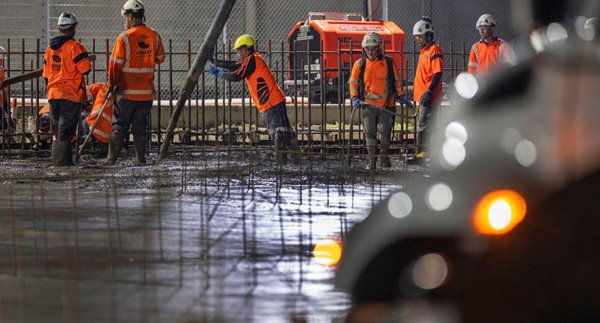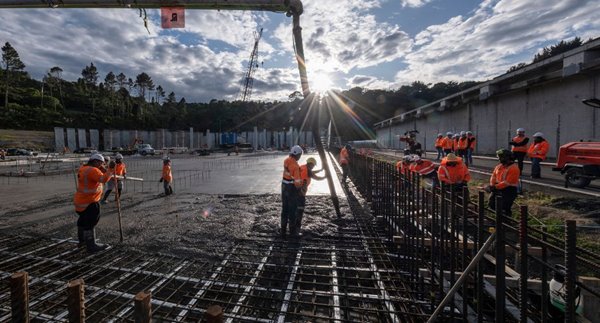
Finding two dry days to complete two concrete pours in summer isn’t normally a problem for the construction industry. But as we can all attest, 2023 has been anything but normal.
Finding two dates amid the January floods and Cyclone Gabrielle for the third and fourth concrete pours of a new 45-million litre water storage reservoir in Redoubt Rd presented us, our construction partner Fulton Hogan and design partner Beca with a unique challenge that required out-of-the-box thinking and collaboration.
Project manager Martin Hughes says wet weather thwarted plans for the third pour on the $60m project, originally planned for mid-January.
"Our original plan was to complete the third pour in mid-January, just after the Christmas break, with the fourth pour following in mid-February. This would have given us time for the third pour to cure and for us to complete the post tensioning of the base, while also completing the installation of the reinforcement and formwork for the fourth pour.
“But since the third pour continued to be delayed by the extreme weather events, we decided to adapt our plans for the fourth pour by completing a large proportion of the preparatory work in parallel to minimise the delay to both pours.
“We ended up doing both pours within two weeks of each other in February. Thanks to the team's determination and ability to focus their attention to other areas of the project – while waiting for a break in the weather to conduct the last two pours – we’ve kept the project relatively on track to meet its April 2024 completion date.”

Once completed, the reservoir will be 106 metres long, 77 metres wide, 8 metres high and contain 650 tonnes of steel reinforcing. It will hold the equivalent of 18 Olympic-sized swimming pools.
The Redoubt Rd reservoir complex can already store up to 120 million litres, and more than 80% of Auckland's treated water passes through it daily. The addition of the third reservoir will increase resilience in the network, thereby future-proofing Auckland's water supply and catering for growth.
"To date we have laid approximately 600m of the new pipe and we have also installed half of the precast concrete wall units to the new reservoir. These are being ‘stitched’ together currently using sections of in-situ reinforced concrete.
"While we were waiting for the weather to clear, we made some headway with the next section of the project by installing some of the precast concrete columns – currently supported by falsework (scaffolding and props) – which will ultimately support the roof of the reservoir.
“To continue momentum on the project, Fulton Hogan plans to bring in a third (450T) truck-mounted crane to speed up the installation of the precast wall panels surrounding the section of the reservoir floor that was covered during the third concrete pour. The rest of the precast wall panels units will be installed by the end of April this year using the existing 280T crawler crane.”
Hughes expects the next two milestones of the project: the installation of the reservoir roof and the preload work for a fourth potential reservoir to be completed before the end of the year.
"Although there is no urgent requirement for a fourth reservoir, we aim to start the preload work in October and finish it in December.
“The preload for the next reservoir will be in place for up to two years. It is designed to replicate the loads that will be transferred to the ground below the new reservoir and to ensure that the majority of any settlement that is likely to occur is complete prior to the new reservoir being built.
“The material we are using to construct the preload is a combination of material already on site that has been used to preload other reservoir sites and material that has been excavated from the site of the reservoir we’re building now. This reduces the carbon impact of the project in line with our target to reduce carbon in our infrastructure projects by 40% by 2025.
“Additionally, to help lower the carbon emissions of the project, we've used fly ash replacement in the cement used to make the concrete for this reservoir.
"It also has greater workability and robustness, thereby reducing shrinkage cracks when compared to other water-based cement mixes."
Hughes describes the completion of the last floor concrete pour as an extraordinary feat that everyone involved in the project should be proud of.
"I have been impressed with the efforts of everyone I've worked alongside – especially when resolving technical issues or having to flip the script to keep the project going during the recent extreme weather.
"I'd also like to thank locals who live near the site for their understanding and patience as we work to deliver this critical infrastructure that will hold an extra 45 million litres of water – boosting our water resiliency."